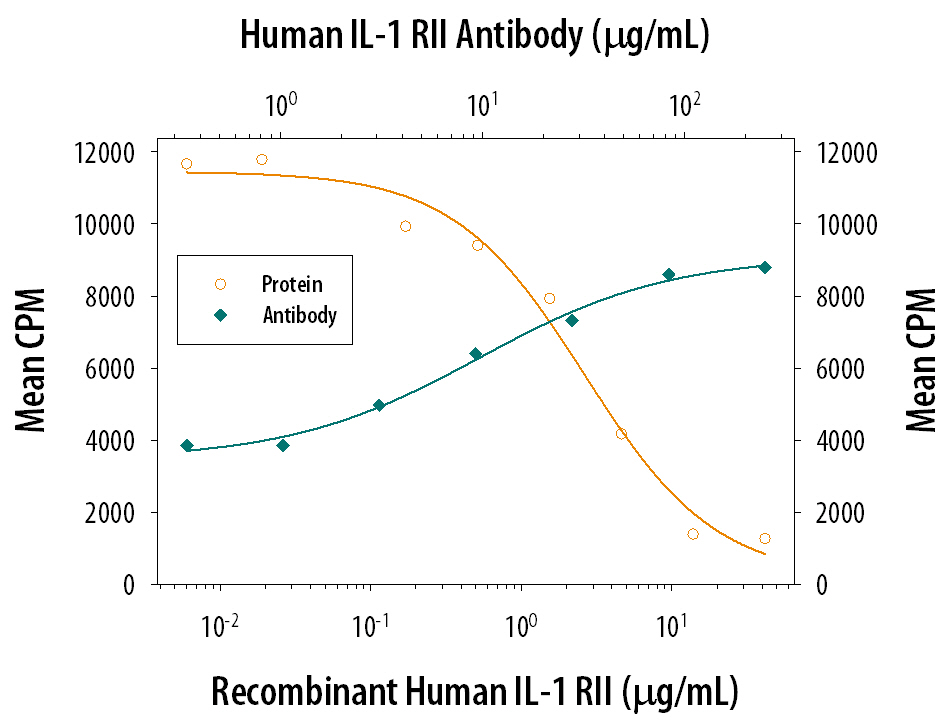Human IL-1 RII Antibody Summary
Phe14-Glu343 (Ser56Gly and Glu297Gly)
Accession # P27930
Applications
under non-reducing conditions only
Human IL-1 RII Sandwich Immunoassay
Please Note: Optimal dilutions should be determined by each laboratory for each application. General Protocols are available in the Technical Information section on our website.
Scientific Data
 View Larger
View Larger
IL‑1 RII Inhibition of IL‑1 beta /IL‑1F2-dependent Cell Proliferation and Neutralization by Human IL‑1 RII Antibody. Recombinant Human IL-1 RII (Catalog # 263-2R) inhibits Recombinant Human IL-1 beta /IL-1F2 (Catalog # 201-LB) induced proliferation in the D10.G4.1 mouse helper T cell line in a dose-dependent manner (orange line). Inhibition of Recombinant Human IL-1 beta /IL-1F2 (50 pg/mL) activity elicited by Recombinant Human IL-1 RII (2 µg/mL) is neutralized (green line) by increasing concentrations of Human IL-1 RII Monoclonal Antibody (Catalog # MAB663). The ND50 is typically 5-20 µg/mL.
Reconstitution Calculator
Preparation and Storage
- 12 months from date of receipt, -20 to -70 °C as supplied.
- 1 month, 2 to 8 °C under sterile conditions after reconstitution.
- 6 months, -20 to -70 °C under sterile conditions after reconstitution.
Background: IL-1 RII
Two distinct types of receptors that bind the pleiotropic cytokines IL-1 alpha and IL-1 beta have been described. The IL-1 receptor type I is an 80 kDa transmembrane protein that is expressed predominantly by T cells, fibroblasts, and endothelial cells. IL-1 receptor type II is a 68 kDa transmembrane protein found on B lymphocytes, neutrophils, monocytes, large granular leukocytes, and endothelial cells. Both receptors are members of the immunoglobulin superfamily and show approximately 28% sequence similarity in their extracellular domains. The two receptor types do not heterodimerize in a receptor complex. An IL-1 receptor accessory protein that can heterodimerize with the type I receptor in the presence of IL-1 alpha or IL-1 beta, but not IL-1ra, was identified (1). This type I receptor complex appears to mediate all the known IL-1 biological responses. The receptor type II has a short cytoplasmic domain and does not transduce IL-1 signals. In addition to the membrane-bound form of IL-1 RII, a naturally-occurring soluble form of IL-1 RII has been described. It has been suggested that the type II receptor, either as the membrane-bound or as the soluble form, serves as a decoy for IL-1 and inhibits IL-1 action by blocking the binding of IL-1 to the signaling type I receptor complex. Recombinant IL-1 soluble receptor type II is a potent antagonist of IL-1 action.
Product Datasheets
Citation for Human IL-1 RII Antibody
R&D Systems personnel manually curate a database that contains references using R&D Systems products. The data collected includes not only links to publications in PubMed, but also provides information about sample types, species, and experimental conditions.
1 Citation: Showing 1 - 1
-
Clinical outcome following acute ischaemic stroke relates to both activation and autoregulatory inhibition of cytokine production.
Authors: Emsley HC, Smith CJ, Gavin CM
BMC Neurol, 2007-02-28;7(0):5.
Species: Human
Sample Types: Plasma
Applications: ELISA Development
FAQs
No product specific FAQs exist for this product, however you may
View all Antibody FAQsReviews for Human IL-1 RII Antibody
Average Rating: 5 (Based on 1 Review)
Have you used Human IL-1 RII Antibody?
Submit a review and receive an Amazon gift card.
$25/€18/£15/$25CAN/¥75 Yuan/¥2500 Yen for a review with an image
$10/€7/£6/$10 CAD/¥70 Yuan/¥1110 Yen for a review without an image
Filter by:
MAB663 was used as the capture and AF263 was used as the detection antibody for the sandwich ELISA for sIL-1R2. The immunoassay standard was 263-2R. Assay had sensitivity of ~10pg/ml.



